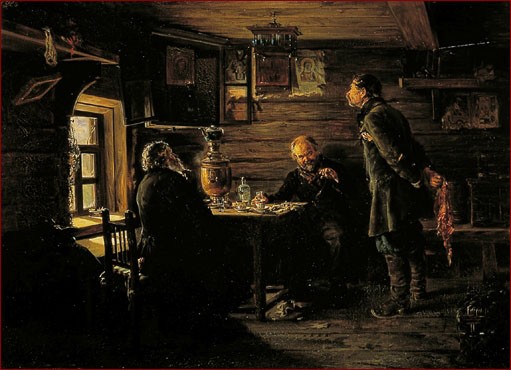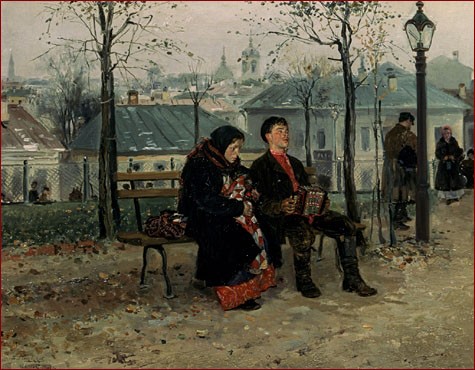Vladimir Makovsky (Владимир Егорович Маковский) (1846-1920)
Get a Makovsky Certificate of Authenticity for your painting (COA) for your Makovsky drawing.
For all your Makovsky artworks you need a Certificate of Authenticity (COA) in order to sell, to insure or to donate for a tax deduction.
Getting a Makovsky Certificate of Authenticity (COA) is easy. Just send us photos and dimensions and tell us what you know about the origin or history of your Makovsky painting or drawing.
If you want to sell your Makovsky painting or drawing use our selling services. We offer Makovsky selling help, selling advice, private treaty sales and full brokerage.
We have been authenticating Makovsky and issuing certificates of authenticity since 2002. We are recognized Makovsky experts and Makovsky certified appraisers. We issue COAs and appraisals for all Makovsky artworks.
Our Makovsky paintings and drawings authentications are accepted and respected worldwide.
Each COA is backed by in-depth research and analysis authentication reports.
The Makovsky certificates of authenticity we issue are based on solid, reliable and fully referenced art investigations, authentication research, analytical work and forensic studies.
We are available to examine your Makovsky painting or drawing anywhere in the world.
You will generally receive your certificates of authenticity and authentication report within two weeks. Some complicated cases with difficult to research Makovsky paintings or drawings take longer.
Our clients include Makovsky collectors, investors, tax authorities, insurance adjusters, appraisers, valuers, auctioneers, Federal agencies and many law firms.
We perform Vladimir Makovsky art authentication, appraisal, certificates of authenticity (COA), analysis, research, scientific tests, full art authentications. We will help you sell your Vladimir Makovsky or we will sell it for you.

Makovsky was the son of collector, Yegor Ivanovich Makovsky, who was one of the founders of the Moscow Art School. Vladimir had two brothers, Nikolai Makovsky and Konstantin Makovsky, and one sister, Alexandra Makovsky. All were famous painters themselves. Vladimir sutided at the Moscow School of Painting, Sculpture, and Architecture. He finished his studies in 1869 and the following year became one of the founding members of the Association of Travelling Art Exhibitions, where his many years of prolific work brought him to a leading position.

Makovsky’s work was defined by a perpetual humor as well as blatant irony and scorn. During the seventies his paintings dealt primarily with small-town folk. His pictures, “The Grape-juice Seller” (1879), “Fruit-Preserving” (1876) and “The Congratulator” (1878) depict various scenes where the mood is finely conceived and almost laughter-inducing. Other works of his, such as “The Benefactor” (1874) and “The Convict” (1878) are profoundly socially-conscious. In them, Makovsky either criticizes the false sympathy of the aristocracy towards the poor, or draws attention to the oppression and persecution of the tsarist gendaremrie. In 1878, he became an academician.

In the eighties, during the time of Russian “democratic” painting, Makovsky produced some of his most revered works. In 1882, he was made professor at the Moscow Art School after the death of Vasili Perov. Some of Makovsky’s greatest works of this period include “In the Ante-rooom of the Court of COnciliation” (1880), “The Released Prisoner” (1882), and “The Collapse of the Bank” (1881). From the end of the eighties, Makovsky began to produce more gloomy works. Quintessential works of this period include “You Shall Not Go” (1892), and “On the Boulevard” (1888).

In 1894, Makovsky became Rector of the Preparatoy school of the Academy of Art. After the First Russian Revolution, he painted “January 9th, 1905, on the Vasilyev Island” in which he depicts the armed police firing at defenseless people. In another painting “The Sacrifices on the Khodyn Field” in which a thousand people lost their lives during the coronation ceremony of Nicholas II, he again stood uncompromisingly on the side of the oppressed people. After the October Revolution, Makovsky helped carry lover the realist traditions to the early stages of Socialist Realism.

Still wondering about a 19th century Russian painting in your family collection? Contact us…it could be by Vladimir Makovsky.
Reviews
1,217 global ratings
5 Star
4 Star
3 Star
2 Star
1 Star
Your evaluation is very important to us. Thank you.
